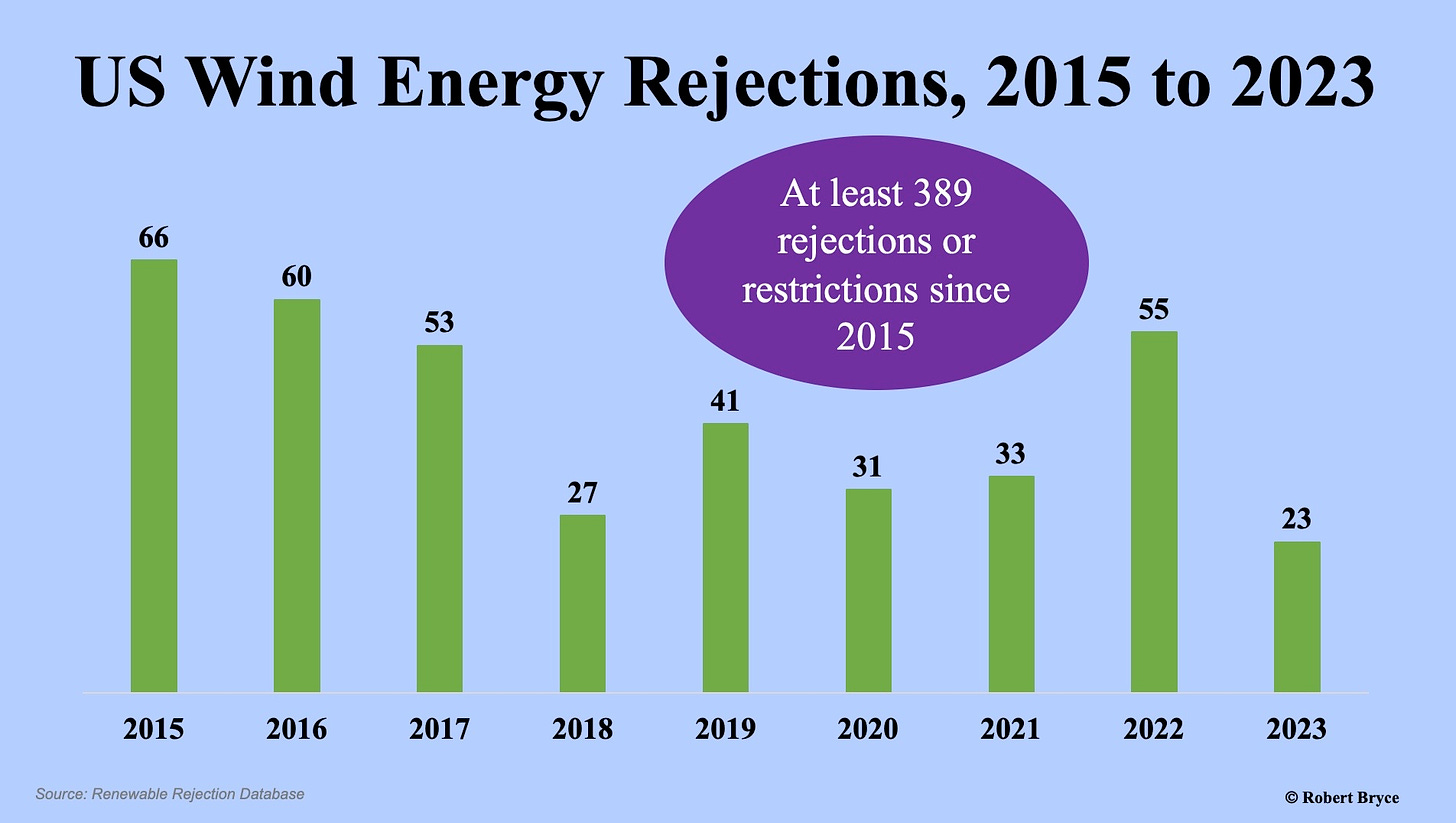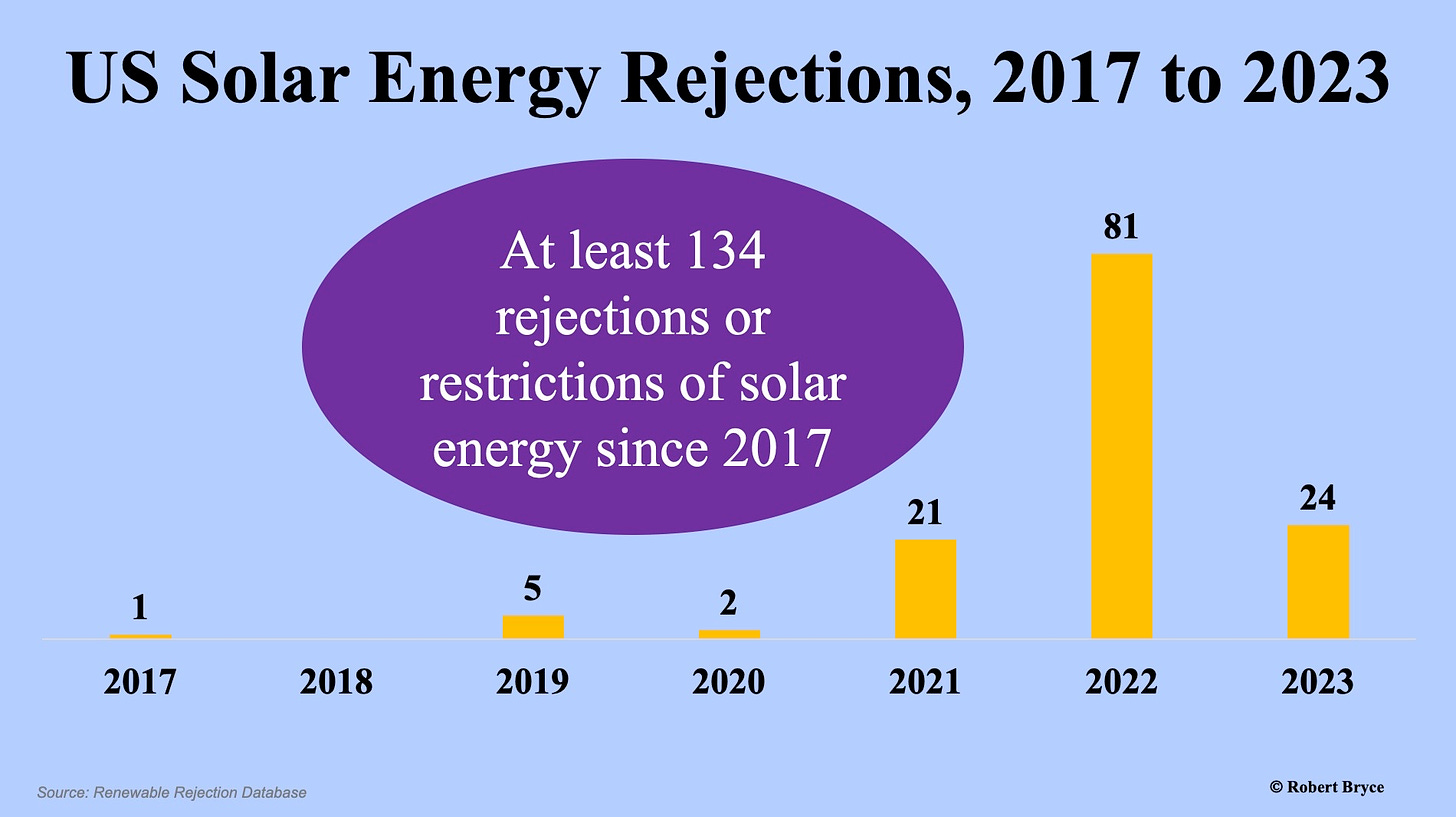Blowback!
Big Wind's getting spiked from Iowa to Ireland; Renewable Rejection Database tally hits 523.
When it comes to siting renewables, the overwhelming majority of the money, media, and momentum is on the side of the companies that want to impose large wind, solar, and battery projects on rural communities. But over the past few weeks, onshore and offshore, from Iowa to Ireland, and Colombia to New Jersey, renewable projects have been getting hammered by a tidal wave of opposition.
I just finished updating the Renewable Rejection Database to include a spate of restrictions or rejections that have been enacted in Iowa, Illinois, and Ohio. The new totals: Since 2015, there have been 389 rejections or restrictions of wind energy projects and 134 rejections or restrictions of solar projects, bringing the total number of rejections to 523. So far in 2023, there’ve been 23 rejections of wind and 24 rejections of solar.
Before going further, let me state the obvious: These hundreds of rejections don’t fit the narrative around “clean” energy that’s been relentlessly promoted by the anti-industry industry, academics, and their myriad allies in the legacy media. But the numbers are the numbers. And the rejections keep piling up. Let’s look at some of the most recent ones.

Last month in Iowa, according to a news report from KRIB, an AM radio station in Mason City, the Cerro Gordo County Board of Supervisors approved “an 18-month moratorium on accepting applications on issuing permits for utility-scale wind energy conversion systems, solar energy installations, and battery storage installations in the rural portions of the county.” The radio station said that 12 people spoke during the “public hearing about the moratorium, with only two being against.” The piece quoted Stuart Seible, a resident of the town of Swaledale (population 144), who told the supervisors he didn’t “want any more windmills around the area of his property.” Seible went on, saying “You’re going to have to live with that ugliness the rest of your life, because these things will last 30 years or so.”
In Illinois, Apex Clean Energy –– which has had its projects rejected in several states, including New York –– saw another of its projects get spiked in March when the Piatt County Board voted against its application for a special use permit to build a 300-megawatt wind project in the county. After the permit was denied on a 3-2 vote, the Piatt County Journal-Republican newspaper quoted Board Member Jerry Edwards, (who voted against the project), as saying “We were elected by the people in our various districts to do what is best for our constituents...I have heard from a lot of residents of Piatt County and for the vast majority, this is something they do not want.”
In response to the vote, an employee of Apex, which is one of the most aggressive renewable developers in America, and is a subsidiary of Ares Management Corporation, a publicly traded investment firm with a market capitalization of some $26 billion, told the newspaper’s editor, Kevin Barlow, “This isn’t over.” The Apex official added, “we have options,” and “we look forward to taking the next steps.”
Ohio continues to be a hotbed of anti-renewable sentiment. In 2021, the Ohio legislature passed SB52, which affirms the right of local communities to have control over the construction of renewable energy projects. The bill, which was signed into law by Ohio Gov. Mike DeWine, (a Republican) passed both chambers of the Ohio legislature but did not get a single vote from a Democratic legislator. In response to SB52, in 2022, several dozen Ohio townships and counties passed measures prohibiting the construction of big renewable projects.
That trend continued this year. Over the past three months, 11 townships in Columbiana County have passed measures prohibiting the construction of large wind and solar projects. A May 11 article published by WFMJ-TV in Youngstown, quoted Columbiana County Commissioner and President Mike Halleck, who estimated “80 to 90%” of township residents in the county are opposed to big renewable projects.

Numerous other wind projects, both onshore and offshore, are being cancelled or are facing fierce opposition. Let’s start with two onshore projects that were canceled last month, one in Ireland, the other in Colombia.
On May 5, in Ireland, the Cork County Council spiked a proposed wind project that would have included seven 150-meter-high turbines in a “scenic area of west Cork.” A resident said the project would be “visually intrusive, out of character” and contrary to “the planning and development of the area.” On May 24, in Colombia, the Italian utility, Enel, announced it had “indefinitely suspended” work on the 205-MW Windpeshi project due to sustained opposition from local indigenous communities. Reuters reported that “Blockades organized since 2021 by the local indigenous Wayuu communities,” have “disrupted the project's construction.”
Now let’s look at the surging opposition to the Biden administration’s plan to install hundreds of giant wind turbines off the East Coast.
On May 23, in New Jersey, the Cape May County Board of County Commissioners unanimously passed a resolution detailing their opposition to a proposed offshore wind project known as Ocean Wind, which is being pushed by the Danish company, Ørsted. The commissioners said they are authorizing “legal challenges on all fronts, due to the potential damage the project will have on tourism and real estate values. In a press release, Commission Director Len Desiderio said, “It is clear to us now that the approach among this foreign corporation and their partners in the state and federal governments is to build these things as fast as they can despite the potential for devastating environmental and economic impacts. On behalf of the people of Cape May County, we will not let that happen without a fight.”
Desiderio also said, “we cannot sit quietly by as hundreds of windmills are installed off our beaches as state and federal government agencies ignore our legitimate and serious concerns.”
On May 24, 50 East Coast mayors sent a letter to members of Congress demanding an “immediate moratorium on all offshore wind activity until the connection between offshore wind activity and marine mammal mortality occurring on our shorelines is thoroughly investigated.”
On May 26, Beth Lowell, a vice president at Oceana, an international non-profit that focuses on ocean conservation, published a piece in The Hill in which she said her organization wants a 20-kilometer buffer zone between the proposed 800-megawatt Vineyard Wind project, and foraging areas for the critically endangered North Atlantic Right Whale. The project is to be built south of Nantucket and Martha’s Vineyard, in an area that’s known habitat for the North Atlantic Right Whale.
It's essential to note that like the Ocean Wind project, Vineyard Wind is being pushed by foreign companies who are eager to snap up lucrative tax credits that Congress has handed out under the Inflation Reduction Act and other legislation. The project is owned by Avangrid, a subsidiary of Spanish utility Iberdrola, and Copenhagen Infrastructure Partners. If the $3.5 billion project gets built, the two companies could collect hundreds of millions of dollars in federal tax credits.
In The Hill, Howell wrote that “it’s not too late” to save the whales. She continued, “we must take a precautionary approach when building new industrial projects in their core habitat areas. We can easily make space for these whales with a conservation buffer zone off Nantucket Shoals, as recommended by the federal government’s own experts...we must save this critically endangered species from extinction.”
If Oceana gets the buffer zone that it has requested, the entire Vineyard Wind project could be scuttled, a move that would be great news for whales and consumers alike.
I will end by repeating two points that I’ve been making for years. First, the key problem with wind and solar (in addition to their incurable intermittency) is their low power density. For wind, it is 1 watt per square meter. Solar’s power density is about 10 watts per square meter. That low power density means they need lots of land (or ocean) to produce significant quantities of electricity. And we don’t have any “vacant” land available. Indeed, the Renewable Rejection Database proves that local communities from Maine to Hawaii have been resisting the energy sprawl that comes with wind and solar for years.
Second, if we are serious about reducing emissions, the way forward is obvious. It is N2N: natural gas to nuclear. Both technologies are low- or no-carbon, mature, affordable, and scalable. Better still, they have power densities that are measured in hundreds, or even thousands, of watts per square meter.
Alas, big business, big banks, and big law firms can’t make as much money off of natural gas and nuclear as they can from wind and solar. Indeed, Congress has dropped a neutron bomb of cash on the wind and solar industries that I have calculated will cost federal taxpayers some $240 billion between now and 2031 –– and that number is almost certainly too low.
Charlie Munger famously said, “show me the incentive and I’ll show you the outcome.” The multi-billion-dollar incentive for Big Wind and Big Solar is to continue pushing their landscape- and marine-mammal-destroying projects on our landscapes and oceans. Given that incentive, we shouldn’t be surprised at the outcome.
Note: I corrected a mistake regarding the name of the wind project that is opposed by Cape May County. That project is Ocean Wind. (H/t to my friend, Jonathan Lesser.)
Before you go:
If you like this piece, please hit the ♡ like button. And if you haven’t done so already, please subscribe. (And share.)
A reminder: I do a lot of public speaking. It’s how I make my living. If you are having an event and need a speaker, ping me.





Thank you Robert! Big Wind should be pushed back for many reasons. In my mind, the main reasons are it is intermittent generation that cannot replace coal, gas and nuclear. After years of subsidies, it is still expensive and unreliable.
I appreciate your documentation of the opposition to industrial-sized (and inherently intermittent) solar and wind generation schemes. However, greedy subsidy-seekers are using "hardball" tactics to secure their taxpayer - funded subsidies. Doomberg on May 26, 2023 criticized Warren Buffet's Berkshire Hathaway Energy in the article, "Blight of the Plebs." HTTPS://SUBSTACK.COM/NOTES/POST/P-123795870 He shares your correspondence with him in the article:
“The context for MidAmerican Energy’s aggressive legal tactics against Madison County is important. In December 2020, the Madison County Board of Supervisors—responding to the anti-wind sentiment of county residents—passed an ordinance that prohibited the installation of wind projects within 1.5 miles of non-participating landowners, limited the height of turbines to less than 500 feet, imposed strict noise limits, and eliminated property-tax breaks. The next month, MidAmerican sued the county to try to force it to accept a wind project the county didn’t want. Why? It stood to lose $81 million in federal tax credits.
MidAmerican’s lawsuit shows yet again, the bare-knuckled legal strategy the wind industry is using against rural Americans as part of its effort to collect billions of dollars in tax credits. For a moment, imagine the media coverage if Exxon, or Chevron, had acted like MidAmerican in Madison County. It would’ve been front-page news in The New York Times. But because the lawsuit involved MidAmerican and the wind industry? Crickets.”
(Berkshire Hathaway Energy (BHE) also operates about 6,000 MW of coal - fired generation - mostly in Wyoming - and 3,000 MW of natural gas fired generation via its PacifiCorp subsidiary. Via FERC, BHE recently sneaked through portraying their fossil-fired generation as "reliability resources" for the American West in Docket ER22-2762. BHE has also backed California's controversial grid regionaliztion bill AB 538 (Holden) which is currently suspended in the California Assembly Appropriations Committee. So BHE is an important fossil energy player as well.